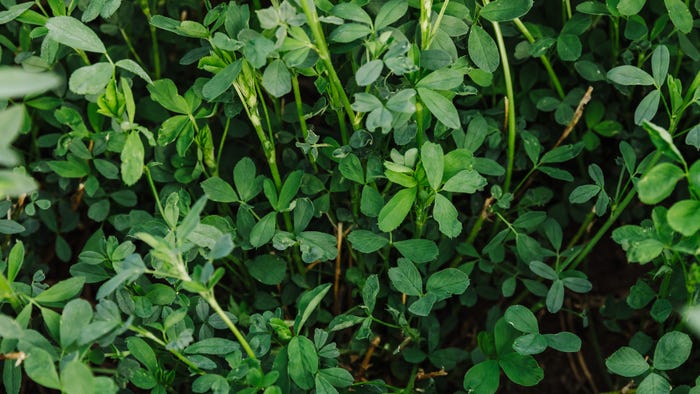May 18, 2023

Photo courtesy of Forage Genetics International
Iowa has had good rainfall so far this spring. While it slows work on row crops, it makes the established alfalfa and grasses grow well. Spring and early summer are also a good time to keep an eye on diseases and pests that could affect hay quality.
“Spring is a good time to check for alfalfa diseases due to cool temperatures and frequent rains, which can promote the development of leaf diseases in some alfalfa fields,” says Joshua Michel, Iowa State University Extension field agronomist. “Second- and third-year and older stands have greater disease risk compared to first-year stands. Fields in lower spots with high soil moisture have higher disease risk.”
To control high levels of disease, an early cutting is generally recommended, Michel says, so defoliation can be avoided. Cutting as early as mid-bud stage can help prevent severe defoliation.
Top 3 diseases
A few different diseases can cause yield loss in alfalfa. The differences in diseases can vary with different varieties. Michel says the three most common diseases in Iowa are:
1. Spring black stem. It produces numerous small, dark-brown-to-black spots first on the lower leaves and petioles, and later on the stems. Michel says the irregularly shaped lesions on leaves increase in size and coalesce. The lesions on stems and etoiles enlarge and may blacken large areas near the base of the plant. The fungus causing this disease is dispersed by splashing rain and can result in defoliation in severe cases.
2. Downy mildew. This disease is caused by the fungus Peronospora trifoliorum. This fungus infects alfalfa in the spring when temperatures are low and moisture is high. Symptoms of this disease are chlorotic blotches on the upper leaf surface and a white-to-gray mold on the lower leaf surface. The fungus survives in shoots over the summer and spreads in the fall. If the disease is a problem, Michel suggests planting a resistant variety the next time.
3. Leptosphaerulina leaf spot. The disease mainly attacks young and old leaves. Lesions start as small black spots that may enlarge. The lesions have light-brown-to-tan centers with darker-brown borders and are often surrounded by a chlorotic area. Michel says this disease is dispersed similarly to spring black stem by splashing rain.
Other diseases to watch for
Mitchel Oswald, account manager for Forage Genetics International, says additional diseases to look for are anthracnose, which can appear at any time in the growing season. Its diamond-shaped lesions can lead to stem rot, and a black or bluish-colored crown. The disease causes plants to weaken at the point of the lesion and to lodge. Planting alfalfa varieties resistant to anthracnose is the most effective strategy for preventing forage and stand losses.
Aphonomyces is a fungal disease that causes yield loss and prevents nutrient uptake. Oswald says this can also cause chronic root rot, with roots showing a brown decay and mucus strain. The rotted root system will cause stunted plants with red stems, and yellow or purple leaves due to a lack of nutrients.
“Aphonomyces looks a lot like nitrogen deficiency since the plant is so stunted. The plants are struggling to get nutrients due to the damage of the root system,” Oswald says. “This can also open the door for secondary disease infections, which can kill the plants.”
This disease is common in wet and poorly drained soils, and shows up after large amounts of rainfall.
Insect pressure
“The No. 1 alfalfa pest as far as insects is potato leaf hoppers,” Oswald says. “They are a mid- to late-season pest, but move in and can drastically reduce our seeding yields without taking oats off at the proper time. The potato leaf hoppers can do a number on the alfalfa.”
He suggests seeding at a 50% rate to get less competition from the companion crop. Take the companion crop off at boot stage before the head emerges, so alfalfa can intercept sunlight sooner. Using an earlier-maturing companion crop will help prevent pest problems for the alfalfa underneath. While potato leaf hoppers do not overwinter in Iowa, they are brought north in the spring on storms from the Gulf of Mexico.
Alfalfa weevils, which are primarily defoliators, can be a problem, especially in early-season growth. Severe infestation can reduce tonnage and forage quality. The weevil is generally more of a problem early in the season. Oswald says the larvae is slate-colored and will turn green. The pest skeletonizes the alfalfa plants and can cause damage quickly if not treated.
Michel says scouting fields for these pests helps with controlling the problem. Management tactics include taking an earlier cutting or spraying an insecticide based on the year of the stand and the quality of the forage. “Most producers will generally take an earlier cutting if insect thresholds are getting close,” he adds.
Time to rotate
Oswald recommends using a companion crop like oats or barley to get an alfalfa crop started. After three to four years of a stand, a rotation is recommended.
“The benefit of using alfalfa in a rotation is that there will be a 150- to 190-pound nitrogen credit in the ground, which is enough for a small grain or corn crop to grow well,” he says, adding that alfalfa’s established taproots will also help reduce erosion.
The amount of nitrogen stored in the soil from alfalfa can help increase corn yields 10% to 20%. Michel says it’s important to know the number of healthy alfalfa plants per square foot before determining if it’s time to rotate out. The number of healthy plants per square foot decreases with the age of the stand:
first-year stand at 12 or more plants
second- and third-year stand at six plants
fourth year or older at four plants
“Typically, forage grasses may fill in the gaps and compensate some towards the yield of the field as the number of plants per square foot slowly declines,” Oswaldsays. “When it is time to change the crop in the field, it’s good to rotate to a different crop for at least one year before planting it back into alfalfa, as auto-toxic compounds from the previous stand will negatively affect the new seeding.”
Growth and harvest
Oswald recommends knowing the soil’s fertility to ensure the plant has the needed nutrients of potassium, potash, phosphorus and sulfur for optimum growth. Proper planting depth into a firm seeding bed will help the plants thrive.
“Rather than going off a calendar, alfalfa should be harvested based on the height and maturity stage of the plant to estimate the relative feed value. In general, it is recommended to harvest alfalfa at about 150 RFV for milking dairy herds and 125 RFV for heifers, stocker cattle and lactating beef cattle,” Michel says.
The RFV of first-crop alfalfa can drop 3 to 5 RFV points per day after it reaches peak value, he says. RFV adjustments also need to be made for harvest loss. Even under the best harvest conditions, 10% to 20% of the forage dry matter can be lost at harvest. It’s important to consider weather forecasts and allow for proper drying time when deciding when to harvest alfalfa.
“In general, don’t cut alfalfa after Sept. 1, or 45 days before the first killing frost, unless you really need the feed,” Oswald says.
Nutrient quality can change after the plants have experienced temperatures of 24 degrees F for four or more hours. This allows the plant to accumulate enough stored carbohydrate reserves to survive the winter. He recommends 8 to 12 inches of stubble to insulate the crop and protect it through the winter.
Read more about:
AlfalfaAbout the Author(s)
You May Also Like






